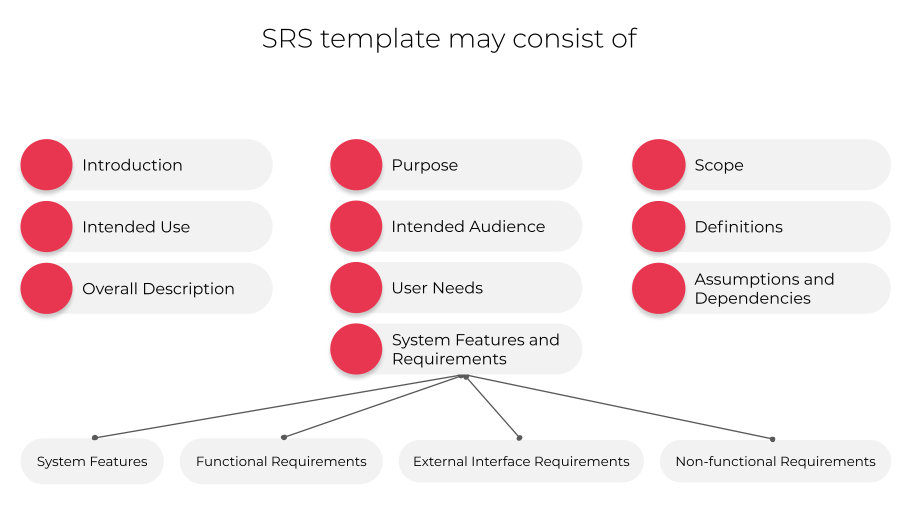How to Create a Clear High-Quality SRS Document

Any application begins with an idea and application development starts from a Software Requirements Specification (SRS) document. The more accurate, business-specific and understandable this document is, the less time and effort your team will spend on realizing the idea. In this article, we will share proven insights on how to create a requirement specification document efficiently.
When You Need an SRS Document
Before proceeding with practical tips, let’s discuss the main goal of creating a software requirements specification. It is a document specifying all the necessary features to make the app work. It focuses on the user journey and defines the expected result. It is essential to create it since it contributes to a better understanding between the stakeholders, the project manager, and the design, development and testing teams.
If you look at the software requirements document example, you will find a project development guide with main milestones and a description of the expected outcome. With its help, each team member may be sure that the software development process is on the right track.
An SRS document is also very important for the product owner since it is the main tool for creating a project development schedule, evaluating risks and determining the necessary time and budget.
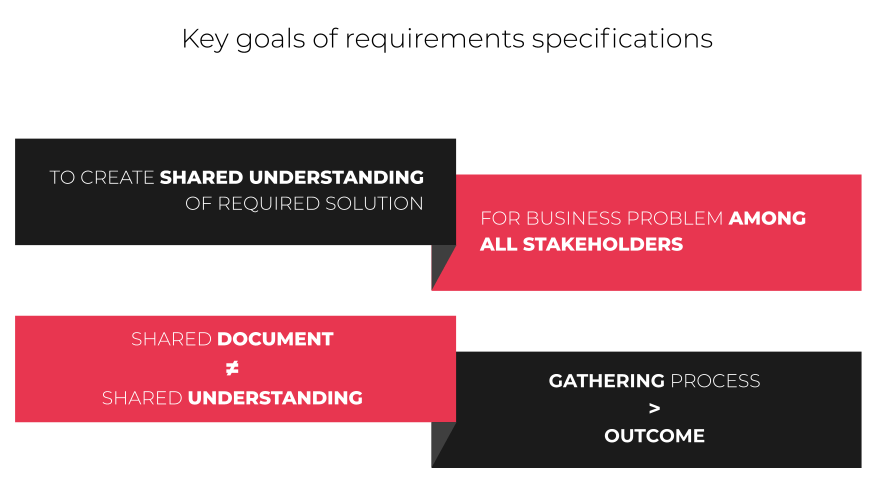
What Makes a Good Software Requirements Specification
If you review the software requirement specification samples, you will find that all of them are quite clear, realistic and well-structured. Cprime uses an SRS template consisting of the following sections:
- Introduction
- Intended use
- Overall description
- Purpose
- Intended audience
- System features and requirements
- Scope
- Definitions
- Assumptions and dependencies.
The following characteristics also point to good software requirements specifications. They should be:
- Explicit. An SRS document should be easy to understand. It should have no vague statements so that there are no misunderstandings between stakeholders.
- Measurable. The requirements need to be measurable so the finished product can be validated and verified against the specifications requested.
- Complete. An SRS document should have enough information for your development team to finish the product. With it, testers need to validate whether the product meets the user’s needs and is bug-free.
- Viable. The requirements should fit the current environment, including the budget, timeline and technology. It shouldn’t depend on upcoming technological breakthroughs.
- Flexible. Since the working environment can change, your document should be flexible enough to have room for updates. Don’t add redundant information to multiple sections that have to be updated with each change.
- Verifiable. Everyone on the development team should have access to the document to reference it as frequently as necessary. Software requirements need to be precise – so that team members do not have to ask for more details.
- Consistent. The requirements should agree with each other. The whole document should be formatted consistently and use the same terminology throughout.
- No Implementation Constraints. A software requirement specification should be detailed enough to finish the job. Don’t make it overly specific because that might restrict development or introduce excess risks. A lot of development depends on third-party services that developers have no control over.
- Accurate. The goals in a software specification requirements document should be precise to avoid confusion. Try to avoid the following:
- Loopholes: “The application should load in 3 seconds if it can be done.”
- Ambiguity: “The MVP product should be released as quickly as possible.”
- Subjectivity: “The UI should be user-friendly.”
- Superlatives: “This should be the best application in its class.”
- Comparative: “This application should be better than Slack.”
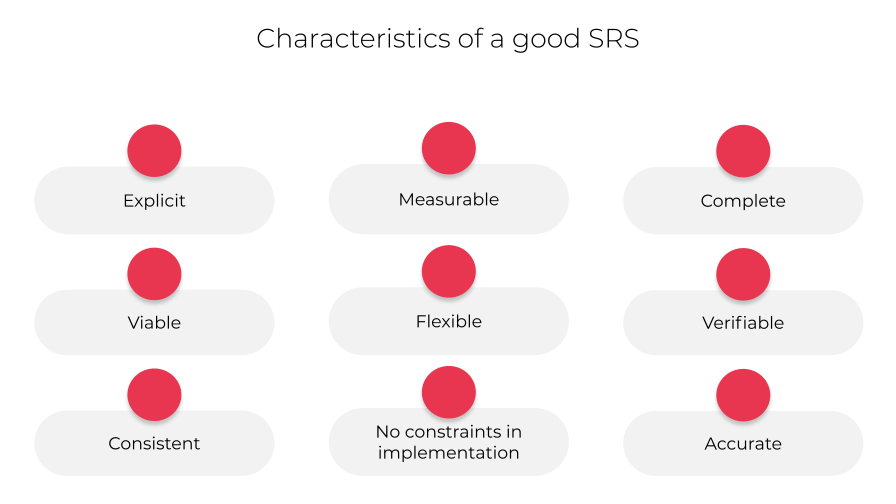
How to Gather and Unify Requirements From Stakeholders, Users, and the Development Team
An SRS document should contribute to better understanding between everyone working on the project creation. It should match stakeholder expectations and user preferences, plus it should take the current market and business environment into account. You need to collect, review and analyze the opinions and visions of each party involved to achieve mutual understanding. You can use the following approaches to gather requirements to power your system requirement specification guideline.
- Individual review. According to this approach, each team member can express the opinion later reviewed by others. For instance, you may create a simple software requirements document in a cloud service, share it with stakeholders and team members, and invite them to make comments.
- Formal methodologies. As part of this strategy, creating an SRS document may be reviewed as a subproject with a logical task flow. For example, to gather stakeholder requirements, analyze the market, etc.
- Creation of design examples, mockups and wireframes. This approach is great for visualizing a future solution, plus it can be instantly tested for user acceptance with the help of heat mapping.
- Brainstorming the ways to deliver more value with your software and specifying the winning ideas in your software requirements document is one most effective strategies.
- After the requirements from stakeholders, users, designers and developers are aligned, you can create a future solution prototype and test it with the users one more time.
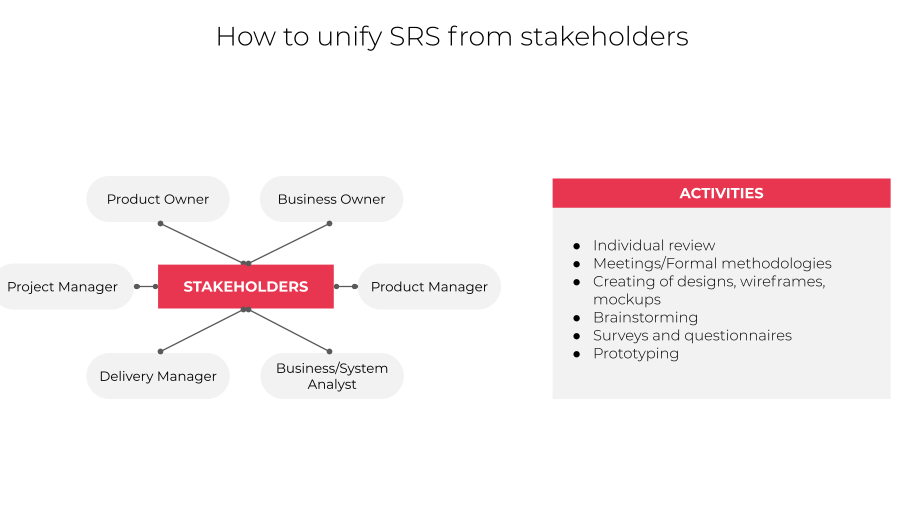
How to Validate the Requirements Before Including Them in the Specification
The right way to validate your software specification requirements is to conduct a business analysis. During this process, the business analyst (BA) will be able to take a deeper look at the company specifics, its current needs, tasks, the challenges it faces, the future market the software is expected to enter, as well as the preferences and expectations of the target users. In the case of enterprise solution development, you need to find out how the solution will be integrated with the existing technologies and make sure it will be easy and effective for employee use.
Also, creating mockups and prototypes is the right strategy for preliminary user acceptance testing. This approach follows the best Lean practices and helps you avoid mistakes in the early stages of project development.
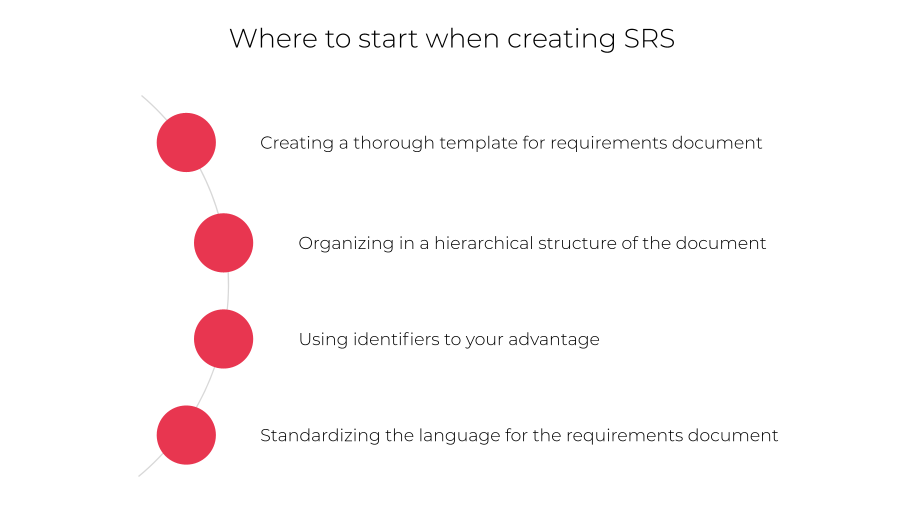
How to Make Sure the Specification is Clear and Unambiguous
Like most spoken languages, English is full of words that have multiple definitions with subtle shades of different meanings. It is a great thing when it comes to self-expression, but it can also lead to confusion and disagreement when it comes to specifying and interpreting SRS.
Thus, before getting started with software specification requirements creation, make sure that stakeholders and development team members have the same understanding of certain words or terms used. It is especially important to avoid synonyms. For example, if you started to use the term equities, do not use shares, or it may be unclear if you mean something different.
An effective practice is to hold a separate meeting where you discuss and write down every concept covered in the document and clearly explain what they meant to make sure everyone is on the same page.
Experts also suggest using the following tricks to come up with the clearest possible software requirements document:
- Use an active tense. In simple words, avoid passive voice when structuring your sentences in your SRS document, and follow a clear structure consisting of a subject, predicate and necessary additions. Try to shorten and simplify the latter as much as possible.
- Do not mix up the requirements. Here the rule of college essay writing applies. Each paragraph should contain only one key idea of your essay. In terms of specifications, one paragraph = one requirement.
- Specify and define the terminology you use and don’t come up with new terms or substitute them.
Samples of Good and Bad Specifications
To get a clear idea of writing your software requirements correctly, compare the following good and bad software requirement specification examples. Below is what your requirement specification should and shouldn’t contain.

Conclusion
Cprime has more than 20 years of practical experience in software development. The company employs tech-savvy business analysts and project managers that are ready to help you gather your requirements and validate your ideas.
Our development team will be happy to create your solution according to the requirements you’ve specified so that you can have a quality product that adds business value!
